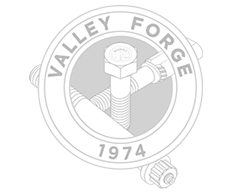The Latest At Valley Forge
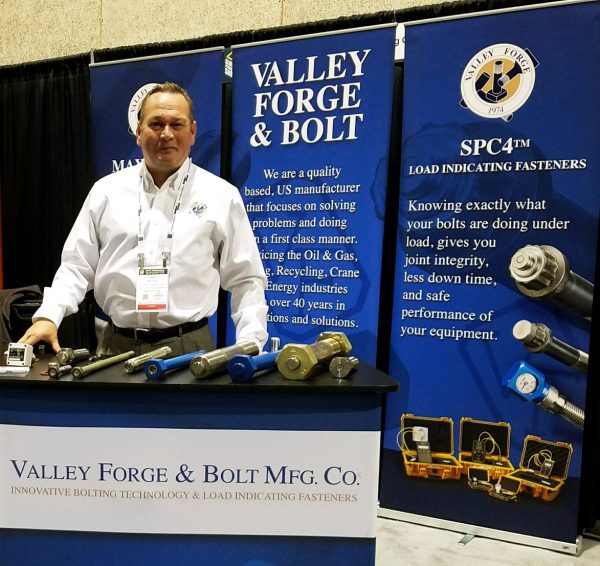 James Brooks joined Valley Forge earlier this year and has moved to Phoenix to head up our Engineering and Business Development areas. An Engineering graduate from London U.K., James has lived and worked in the USA since 1995. His expertise is in being solutions oriented leading companies in Aerospace, Powergen, Defense and Fastening, with over 10 years of experience in the critical bolting segment, working in operations, business development and global strategy. We at Valley Forge are excited to have James on the team.
James Brooks joined Valley Forge earlier this year and has moved to Phoenix to head up our Engineering and Business Development areas. An Engineering graduate from London U.K., James has lived and worked in the USA since 1995. His expertise is in being solutions oriented leading companies in Aerospace, Powergen, Defense and Fastening, with over 10 years of experience in the critical bolting segment, working in operations, business development and global strategy. We at Valley Forge are excited to have James on the team.
We recently spent some time with James and asked some important questions:
Why Valley Forge?
James: I have an opportunity to be a part of a company that is first in its field and is constantly innovating… that’s my kind of company, after all, who wants to follow when you can lead?
Valley Forge has reputation for service, quality and successful problem solving. It’s rare to find a fastener company with these qualities, coupled with in-house forging, heat treating and great vertical integration.
What is your plan?
James: The critical bolting world is changing. For many years I have been involved heavily in educating several industries – in order to bring greater awareness to the benefits in safety, accuracy, reliability and maintainability through the adoption of bolted joint tension based tightening methods [versus torque].
Our future, and frankly our “today” in Engineering involves the support of existing Valley Forge technologies and the development of new products which continue to provide many industries with access to products which provide tension-based bolting advantages.
We have thousands of tension verifying bolts now installed worldwide, many of which are now coupled with our new generation of WiFi enabled remote tension sensors.
Significant efforts are being directed towards the expansion of our wireless bolt monitoring devices. We are working with a variety of wireless and internet communication technologies: all of which will provide an ability for bolted joints to be remotely monitored.
What Will Valley Forge Engineering look like going forward?”
James: Since the beginning of the year, we invested in growing our Engineering and Research Group. With additional Electrical and Mechanical Bolting Specialists who are not only trained in design, but also problem solving. Our Engineers can help both from our Phoenix HQ and in the field. We will also have platforms on additional strategic international locations.
The spring ASTM Committee F16 on Fasteners meeting was held this past week and was attended by several Valley Forge members.
The purpose of the F16 Committee, which is broken into subgroups, is to maintain, update and improve existing standards.
The various subcommittees conducted their usual business and F16 main wrapped up on Tuesday afternoon.
This report is intended to high lite some of the major issues and topics from the meetings.
ASTM F2482 Load-Indicating Externally Threaded Fasteners
During the F16-02 meeting a representative of Industrial Indicators (formally Stress Indicators) requested that a task group be formed to include their product, Smart Bolt & the “Chroma Series”, into the F2482 specification. Several years ago, F16 made a determination to reduce the number of fastener standards by grouping like product standards. Although the F2482 standard is not up for renewal until 2020, it was agreed that a task group be formed. Valley Forge was initially a principal in the introduction and the writing of this standard. It is expected that the rewrite of the standard will be divided into two (2) distinct categories. They will be the original “Measuring Type” and a “Go/No Go” type. Valley Forge will participate in the work group to insure the integrity of the standard and the clear distinction of the two (2) types.
F16.96 Subcommittee on Bolting Technology
The interesting aspect of this committee are the Technical Presentations delivered by various companies. The representative of Industrial Indicators (formally Stress Indicators) introduced their new “Chroma Series” tension indicating fastener. Unlike their Smart Bolt it requires a chromatic displacement transducer to determine if the predetermined tension has been reached. It was presented as an upgrade of the Smart Bolt with an expected accuracy of +/- 5%. To date the development is being completed, and a protoype unit was on display for inspection.
F16.97 Coordination with North American TAGs to ISO TC 2 on Fasteners
ISO TC2 on Fasteners worldwide representatives will be meeting in Montreal Oct. 15 – Oct. 19.
In the last meeting the Chinese Delegation presented an interesting item. They had wished to include in ISO 898, a product in class 8.8 & 9.8, using non-heat-treated material. They have been using this material throughout China for several years. Their attempts at 10.9 have not been successful. This concept was totally rejected by the committee. The question is “will this product find its way into North America”?
After several years of discussion, testing and review of results, ISO 4042 has been voted on and accepted. This is an electroplating specification that somewhat follows ASTM F1941 removing baking for items 360 HV and below. They however, put in a grey area between HV 360 – 390 that cautions the specification user that they may wish to consider baking. We will understand this new specification better once we obtain a printed version.
B08 Metallic and Organic Coatings
B08-06 Soft Metals
As most of you are aware there are two (2) standards within ASTM, both pertaining to electro deposited zinc. They are F1941 & B633 and they disagree at what hardness is baking to be performed. In 2007, B633 was change to make baking mandatory at RC31, grade 5 or higher. The B08-06 committee has claimed that there was work performed to support this change. They however; have not presented the supporting documents. ASTM has stated that they will not become involved to resolve the discrepancy. It must be resolved by the individual committees. The specification has now been basically rewritten and submitted for comments.
Of course, many negatives were received and an all-day work session was held on Wednesday to resolve the negatives. Basically, many of the areas of the document were rewritten and restructured to resolve the negatives. At the end of the day there still remained negatives. It was decided to once more send out the rewritten specification for a vote. The negative comments will be dealt with at the next meeting or by special action by the voting members. It is believed that the majority of the voting members will accept the rewritten standard and find the negatives “non-persuasive”. The rewriting of this standard and the removal of the requirement for baking beginning at RC31 is very important. Valley Forge has a voting member serving on this committee.
We are happy to announce that James Brooks has joined Valley Forge as Director of Engineering and New Business Development.
James is an engineering graduate from the University of London (UK) and brings significant experience in the field of specialty engineered fastening solutions. This includes direction of a large Swedish/US specialty fastener company. In addition, he has significant experience in the development and execution of global strategies along with a long list of sales growth. We are excited that James will soon be moving to Phoenix, Arizona to our US Corporate Headquarters.
James adds, “[He is] delighted to be joining the team at VFB. Timing is great as Valley Forge has the proven capabilities to innovate and support the next generation of fasteners. Their bolted joint monitoring solutions are being increasingly sought after in many industrial market segments.”
The month of October celebrates Manufacturing Month. On Friday, October 6th, we celebrated MFG Day at Valley Forge. We welcomed a variety of students and the public into the shop and had two tours of the facility. Each group toured the VF shop and had the opportunity to explore and get an in depth view of our advanced ERP System, engineering, drafting and design, large hot-headed forging, heat treat, roll threading, CNC machining and Load Indicating Technology. We also received a special visit from Todd Boppell, the COO of NAM (National Association of Manufacturers). Todd helped us to communicate the reason for MFG Day across America, to help dispel the stigma of working in manufacturing.
ABC15 News reporter John Genovese stopped by, filmed one tour and did some great interviews in the shop. VFB made the news program on Monday, October 9 with the story below.
By: John Genovese
PHOENIX – A Valley business is hoping to inspire the next generation of manufacturing workers.
“You can learn other skills and still be a valuable member of the community without having a college degree,” said Michele Clarke, CEO of Valley Forge & Bolt.
The company, which employs around 80 people and produces industrial fasteners that are shipped around the world, has been in the Phoenix-area since the 1970s.
“We make a quality product, and we stand by our product,” Clarke said.
Valley Forge is among thousands of manufacturing companies across the country offering tours this month to lure students and young people to the profession.
The National Association of Manufacturers estimates there are 500,000 open manufacturing positions in the U.S. By 2025; they anticipate an additional 3.5-million jobs will be available.
“Two-million of those are going to be unfilled if we don’t do something about the current skills gap that we have,” said NAM COO Todd Boppell.
Jose Molina, a student, was among those taking part in a tour at Valley Forge.
“There’s a lot more to it than meets the eye,” he said.
Clarke told ABC15 the business is now as much about technology as it is manual labor.
“The innovation that this country was created with can’t be lost,” she said.
Reprint courtesy of ABC15. See more here.
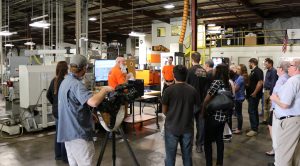
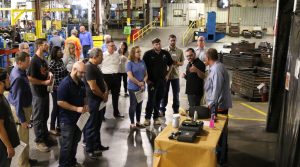


Valley Forge & Bolt Manufacturing Co. in Phoenix has been producing high-quality hot forged industrial fasteners for over 40 years. The manufacturer — which also has heat-treating, threading, and machining capabilities — is well known for its novel (and patented) MaxBolt load-indicating fasteners. Each MaxBolt™ fastener features a tiny, built-in gauge that continuously measures and indicates the level of tension being exerted on the bolt.
Maxbolt fasteners are manufactured by inserting highly accurate and durable load-monitoring devices into high quality bolts and studs. Accurate assembly and continuous monitoring during production reduce the potential for premature wear, expensive downtime, and catastrophic joint failure.
According to Valley Forge & Bolt, load-indicating fasteners are compatible with conventional tightening and tensioning equipment and eliminate the need for ultrasonic, strain gages, and torque measuring devices. The system offers a simple and reliable method for accurate joint assembly, and helps to maintain the integrity of the bolted joint.
MaxBolt fasteners appear simple, but are critical for the types of projects carried out by Valley Forge’s customers, including fabricating and maintaining sub-sea platforms, mining equipment, and assemblies and fabrications used in nuclear laboratories, oil-and-gas processing, construction cranes, and power plants.
In order to operate at the level of reliability and efficiency required for these high-stakes jobs, Valley Forge & Bolt also needs precision and reliability in its manufacturing operation, which is centered on a dozen or so hot-forging machines, mainly mechanical upset presses and punch presses.
Some time ago, Ron Clarke, Valley Forge & Bolt president contacted Sutherland Presses to discuss a new approach to the process of making extra-long bolts. The project continued and evolved into a multi-year collaboration, reviewing existing processes, and developing new targets for safer production and higher output.
 At an early stage of the collaboration it became clear to Clarke that Valley Forge & Bolt had an area of opportunity particularly suited to the strengths of Sutherland Presses. “The conventional forge presses we had were not ideal for long bolt heading,” he recalled. “They forced us to have more moving and rotating parts in our dies in order to load and extract the long bolts.
At an early stage of the collaboration it became clear to Clarke that Valley Forge & Bolt had an area of opportunity particularly suited to the strengths of Sutherland Presses. “The conventional forge presses we had were not ideal for long bolt heading,” he recalled. “They forced us to have more moving and rotating parts in our dies in order to load and extract the long bolts.
“When we met with the team from Sutherland, they came to the table with a fresh idea for a Front-Loading Sliding Table (FLST) Forge Press.” Since it was installed in 2013, the 600-ton vertical press at Valley Forge has become “a signature innovation,” according to Sutherland Presses. The California-based press builder has previously implemented the FLST design for manufacturers producing extra-long bolts for fasteners supplied to aerospace programs.
Valley Forge & Bolt’s Sutherland hot-forge press has been in service for several years now, successfully forging extra-long bolts.
“Due to the front-loading design, the press can be operated manually or automated,” Clarke explained about the machine’s advantages. “There’s less heat loss due to the faster heater-to-forge cycle which creates better material flow, and the precise, close-tolerance slide guide structure has improved die life.”
The extra-long bolts being produced by the FLST press go on to secure some of the most vital connections needed to build heavy industrial equipment. And, those applications are possible because of the precision design and performance, as well as the partnership formed between two industrial innovators.
Valley Forge is very proud to announce that our Load Indicating Fasteners have passed Military Shock Testing Standard MIL-S-901D!!
This is a rigid test that means great things for our fasteners moving forward with many different applications involving any degree of shock to the fastener while in service.
Shock Tests, Requirements for High-Impact Shipboard Machinery, Equipment and Systems
- Specification: Testing was completed per MIL-S-901D, Lightweight, Grade B, Class 1, Type C shock testing requirements.
- Location: Testing was done by Element Material Technology in Jupiter, Florida
- Purpose: The purpose of this testing is to verify the ability of shipboard equipment to withstand shock loadings which may be incurred during wartime service due to the effects of nuclear or conventional weapons.
- Load Indicating products tested:
- Standard SPC4™
- No-Standoff SPC4™
- Single Lever Maxbolt™
- Dual Lever Maxbolt™
- Mini Maxbolt™
- No-Standoff Maxbolt™
- MIL-S-901D is a common requirement for shipbuilders and other companies supporting the US Navy.

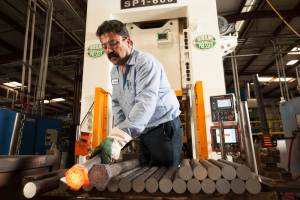 here is plenty of attention paid to the high-precision designs of advanced materials and parts developed for critical applications, but even parts that are seemingly ordinary or standard run projects require an exceptional degree of precision in concept, engineering, execution, and operation.
here is plenty of attention paid to the high-precision designs of advanced materials and parts developed for critical applications, but even parts that are seemingly ordinary or standard run projects require an exceptional degree of precision in concept, engineering, execution, and operation.